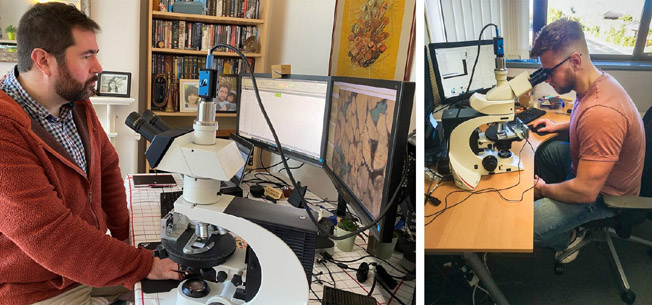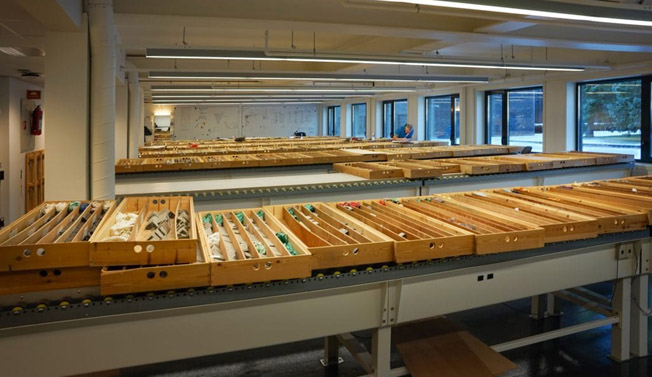The final part of PetroStrat's Sub-Garn Sands project development study are now available to review, following their progress and discovering what goes into the multiclient studies.
Here are all the entries in this series:
Introduction
Building on PetroStrat’s recently completed reservoir quality study of the Garn Formation (2021), this regional investigation on depositional and diagenetic controls affecting reservoir quality is now being extended to the early-mid Jurassic sub-Garn sands complex. PetroStrat will focus on sands coincident with the J30, J40 and J50 biostratigraphically defined sequences (i.e., beneath J50.4-J60.2 defined Garn), assigned to the Ile, Tofte and Tilje formations.
The 28 Halten Terrace wells have been identified with guidance from operators to capture a wide range of location, facies, age and depth (2.2km to 5.5km) of cored sections. This variability will help geoscientists use the database as a predictive tool and reference, as an aid to understand and model reservoir properties. Potential links between depositional facies and sediment provenance, with pore-lining chlorite formed during late diagenesis (observed to resist mechanical compaction and quartz overgrowths) will again be a focus, alongside cement phases including illite, dolomite, kaolinite.
Part 1 – Determining Core And Sample Selection
Ahead of our Reservoir Geologists visiting the NPD Geobank, it was important to first review existing datasets (accessed using DISKOS) to ensure that we’d be capturing a representative variation of Ile, Tofte and Tilje formation sands within our forthcoming reservoir quality analytical programme (petrography, SEM imagery and XRD analysis). As with the completed Garn study (2021), a key aim will be to explore the relationships between lithology, facies, provenance, diagenesis, location, depth and reservoir quality – ultimately to provide geological context on porosity & permeability trends that are much better than may be expected in deeper (>4,000m) sections of the Sub-Garn. For consistency with the Garn study, 1 sample will be analysed for every 10m of core described (i.e., 275 samples across the 2.75km of core)...
Part 2 – Sampling Core At The NPD Geobank Stavanger
Our Sub-Garn project team of John Cater, Paddy Clarke and James Scorgie arrived at the NPD Geobank in Stavanger, armed with the permission to collect core samples, and our sampling points picked in advance from review of stratigraphy, CCA data & NPD core photos (read more about this in Blog Post 1). Given the volume of core samples being collected within this 2-week visit, two assistants from Stratum Reservoir’s team in Stavanger kindly provided additional support...
Discover more
Part 3 – Petrographic Data Capture
Consistently, accurately, and objectively recording variations grain size, and mineralogical composition through our experienced geologists point counting thin-sections – is key to evidencing the relationships between lithology, diagenesis, and reservoir quality in time equivalent sands across a range of locations and present depths.

PetroStrat Reservoir Geologists Dr. Daniel Atkin (left) and Dr. James Foey (right) using a petrographic microscope, with camera attachment, PETROG™ stepper and software to generate grain size and compositional modal datasets via our point counting process
Part 4 – Facies Assignments Using Core Descriptions
Our core descriptions at the NPD Geobank facilities in Stavanger, are being undertaken to consistently define depositional settings across the Tilje, Tofte and Ile formations through ~2.7km of core in 30 study wells. Dr. John Cater, Paddy Clarke, Hannah Torrance, Mirko Looser and Jamie Scorgie are completing this work through visits in November 2022 and January/February 2023. A key aim is to differentiate deltaic settings, and then cross-reference sedimentary facies against authigenic and diagenetic mineralogy based on petrography, to help us understand the causal relationships and controls on reservoir quality.

Sub Garn Sands Blog Part 4 Facies Assignments Using Core Descriptions PetroStrat Staff At NPD Geobank Stavanger
Part 5 – SEM Imagery and Analysis
Our detailed assessments of the depositional and diagenetic controls upon reservoir quality, are aided by acquiring and interpreting SEM (Scanning Electron Microscopy) imagery. Dr. Elliot Rice-Birchall of PetroStrat led this component for our Sub-Garn multiclient. The key additional interpretive value, relative to petrographic observations in thin section, is the ability to visualise relationships between the authigenic components of a sample in three dimensions at nanoscale-level detail. This helps us to determine the paragenetic sequencing (i.e., timing of formation) of cementation phases relative to the host mineralogy, which provides an understanding on the creation, preservation, and destruction of porosity and permeability. For instance, where we observe the late growth of chlorite upon earlier quartz overgrowths, the chlorite content, irrespective of its % proportion in the sample, will be ineffective at preserving reservoir quality. Conversely, in samples with continuous early pore-lining chlorite, the occurrence of other cements (particularly quartz) is much reduced. Where samples are rich in grain coating chlorite cements, we often detect high volumes of fibrous and webby illite, but pore throats appear unaffected by the webby illite...
Part 6 – Data Integration & Reporting
The trends and relationships between well location, stratigraphic sequence, depositional setting, diagenesis and burial depth, as a complex interplay of controls upon reservoir quality became evident as our analytical datasets were integrated and visualised as maps and charts.
PetroStrat elected to map the range, and relative proportions of sedimentary facies observed within each well from cores studied at the NPD, as bubble plots drafted in Interactive Correlations (IC) software, across the 3 biostratigraphically-define timeslices...
KeyFacts Energy Industry Directory: PetroStrat
 KEYFACT Energy
KEYFACT Energy